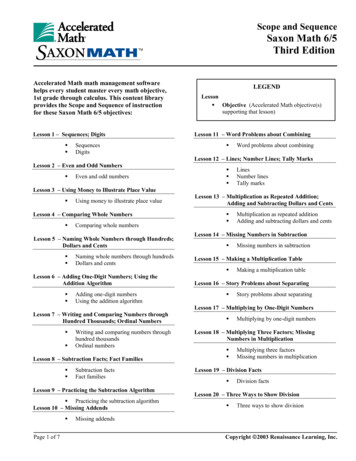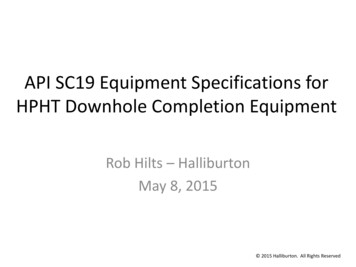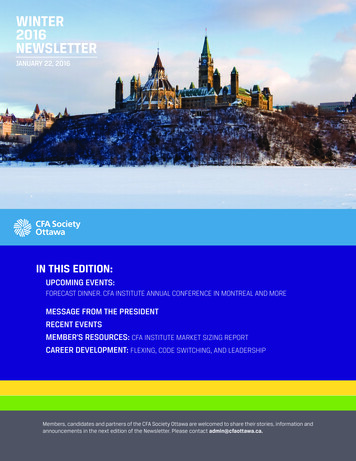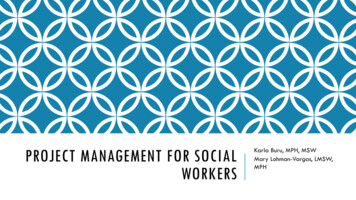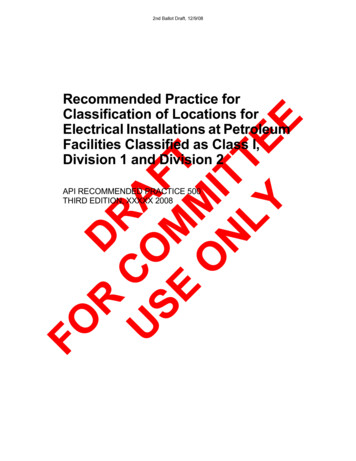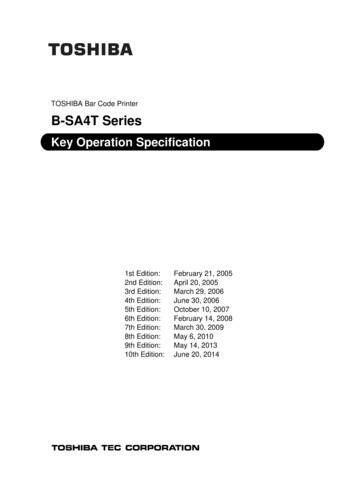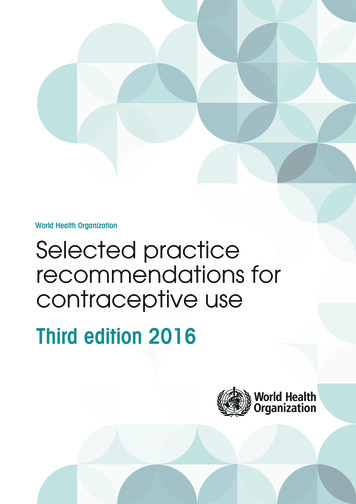
Transcription
World Health OrganizationDepartment of Reproductive Health and ResearchSelected practicerecommendations forcontraceptive useThird edition 2016
WHO Library Cataloguing-in-Publication DataSelected practice recommendations for contraceptive use – 3rd ed.1.Contraception – methods. 2.Contraceptive Agents, Female. 3.Contraceptives, Oral, Combined. 4.Intrauterine Devices. 5.NaturalFamily Planning Methods. 6.Vasectomy. 7.Practice Guideline. I.World Health Organization.ISBN 978 92 4 156540 0(NLM classification: WP 630) World Health Organization 2016All rights reserved. Publications of the World Health Organization are available on the WHO website (www.who.int) or can bepurchased from WHO Press, World Health Organization, 20 Avenue Appia, 1211 Geneva 27, Switzerland (tel.: 41 22 791 3264;fax: 41 22 791 4857; e-mail: bookorders@who.int).Requests for permission to reproduce or translate WHO publications – whether for sale or for non-commercial distribution– should beaddressed to WHO Press through the WHO website (http://www.who.int/about/licensing/copyright form).The designations employed and the presentation of the material in this publication do not imply the expression of any opinionwhatsoever on the part of the World Health Organization concerning the legal status of any country, territory, city or area or of itsauthorities, or concerning the delimitation of its frontiers or boundaries. Dotted lines on maps represent approximate border lines forwhich there may not yet be full agreement.The mention of specific companies or of certain manufacturers’ products does not imply that they are endorsed or recommended bythe World Health Organization in preference to others of a similar nature that are not mentioned. Errors and omissions excepted, thenames of proprietary products are distinguished by initial capital letters.All reasonable precautions have been taken by the World Health Organization to verify the information contained in this publication.However, the published material is being distributed without warranty of any kind, either expressed or implied. The responsibility forthe interpretation and use of the material lies with the reader. In no event shall the World Health Organization be liable for damagesarising from its use.Layout: L’IV Com Sàrl, Villars-sous-Yens, Switzerland.Printed by the WHO Document Production Services, Geneva, Switzerland.
ContentsAcknowledgements3Acronyms and abbreviations5Executive summary6Introduction. . . . . . . . . . . . . . . . . . . . . . . . . . . .Target audience. . . . . . . . . . . . . . . . . . . . . . . .Guideline development methods. . . . . . . . .Summary of reviewed recommendations. . . . . . . . . . . . . . . . . . . . . . . . . . . . . . . . . . . . . . . . . . . . . . . . . . . . . . . . . . . . . . . . . . . . . . . . . . . . . . . . . . . . . . . . . . . . . . . . . . . . . . . . . . . . . . . . . . . . . . . . . . . . . . . . . . . . . . . . . . . . . . . . . . . . . . . .1. Background1.11.21.31.41.568. 810. . . . . . . . . . . . . . . . . . . . . . . . . . . . . . . . . . . . . . . . . . . . . . . . . . . .12Reproductive and sexual health care as a human right. . . . . . . . . . . . . . . . . . . . .Contraceptive choice. . . . . . . . . . . . . . . . . . . . . . . . . . . . . . . . . . . . . . . . . . . . . . . . . . . .1.2.1 Issues of service quality and access that affect method use and choice. .Effectiveness of methods. . . . . . . . . . . . . . . . . . . . . . . . . . . . . . . . . . . . . . . . . . . . . . . .Return to fertility. . . . . . . . . . . . . . . . . . . . . . . . . . . . . . . . . . . . . . . . . . . . . . . . . . . . . . .Sexually transmitted infections and contraception: dual protection. . . . . . . . . . . . . . . . . . . . . . . . . . . . . . . . . . . . . . . . . . . . . . . . . . . . . . . . . . . . . . . . . . . . . . . . . . . . . . . . . . . . . . .1213131414162. Methods173. How to use this document193.13.2Classification of examinations and tests before initiation ofcontraceptive methods. . . . . . . . . . . . . . . . . . . . . . . . . . . . . . . . . . .Contraceptive eligibility. . . . . . . . . . . . . . . . . . . . . . . . . . . . . . . . . . . . . . . . . . . . . . . . . . . . . . . . . . . . . . . . . . . . . . . . . . . . . . . . . . . . . . . . . .4. Programmatic implications4.121Introducing guidelines into national programmes. . . . . . . . . . . . . . . . . . . . . . . . . . . . . . . . . . . . . .5. Clients with special needs5.15.2People with disabilities. .Adolescents. . . . . . . . . . . .19202123. . . . . . . . . . . . . . . . . . . . . . . . . . . . . . . . . . . . . . . . . . . . . . . . . . . . . . . . . . . . . . . . . . . . . . . . . . . . . . . . . . . . . . . . . . . . . . . . . . . . . . . . . . . . . . . . . . . . . . . . . . .23236. Summary of changes within the Selected practice recommendations forcontraceptive use, third edition267. Recommendations277.17.2How can a health-care provider be reasonably certain thata woman is not pregnant?. . . . . . . . . . . . . . . . . . . . . . . . . . . . . . . . . . . . . .Intrauterine devices. . . . . . . . . . . . . . . . . . . . . . . . . . . . . . . . . . . . . . . . . . . .7.2.1 Copper-bearing IUDs (Cu-IUD) and levonorgestrel-releasingIUDs (LNG-IUD). . . . . . . . . . . . . . . . . . . . . . . . . . . . . . . . . . . . . . . . . . . . . . . . . . . . . . . . . . . . . . . .2727. . . . . . . . . . . . . . . . . . . . . . .27. . . . . . . . . . . . . . . . . . . . . . .1
7.37.47.57.67.7Progestogen-only contraceptives. . . . . . . . . . . . . . . . . . . . . . . . . . . . . . . . . . . . .7.3.1 Progestogen-only implants. . . . . . . . . . . . . . . . . . . . . . . . . . . . . . . . . . . . .7.3.2 Progestogen-only injectable contraceptives (POIs). . . . . . . . . . . . . . . .7.3.3 Progestogen-only pills (POPs). . . . . . . . . . . . . . . . . . . . . . . . . . . . . . . . . . .Combined hormonal contraceptives. . . . . . . . . . . . . . . . . . . . . . . . . . . . . . . . . . .7.4.1 Combined oral contraceptives (COCs), the combined contraceptivepatch and the combined contraceptive vaginal ring (CVR). . . . . . . . . .7.4.2 Combined injectable contraceptives (CICs). . . . . . . . . . . . . . . . . . . . . . .Emergency contraception. . . . . . . . . . . . . . . . . . . . . . . . . . . . . . . . . . . . . . . . . . . .7.5.1 Copper-bearing IUDs (Cu-IUD) for EC, and emergencycontraceptive pills (ECPs). . . . . . . . . . . . . . . . . . . . . . . . . . . . . . . . . . . . . . .7.5.2 Resumption or initiation of regular contraception after using EC. . . .Standard Days Method . . . . . . . . . . . . . . . . . . . . . . . . . . . . . . . . . . . . . . . . . . . . . .Male sterilization. . . . . . . . . . . . . . . . . . . . . . . . . . . . . . . . . . . . . . . . . . . . . . . . . . . .7.7.1 Vasectomy. . . . . . . . . . . . . . . . . . . . . . . . . . . . . . . . . . . . . . . . . . . . . . . . . . . . . . . . . . . . . . . . . . . . . . . . . . . . . . . . . . . . . . . . . . . . . . . . . . . . . . . . . . . . . . . . . . . . . . . . . . . . . . . . . . . . . . . . . . . . . . . . . . . . . . . . . . . . . . . . . . . . . . . . . . . . . . . . . . . . . . . . . . . . . . . . . . . . . . . . . . . . . . . . . . . . . . . . . . . . . . . . . . . . . . . . . . . . . . . . . . . . . . . . . . . . . . . . . . . .33333742464753565759626363Web annex: Development of updated guidance for the third edition y planning/SPR-3/en/)2Selected practice recommendations for contraceptive use Third edition 2016
AcknowledgementsThe World Health Organization (WHO) would like to thank the members of the GuidelineDevelopment Group (GDG) and the Evidence Secretariat for their contributions throughoutthe development of these recommendations. WHO convened three consultations (13–16 May2013, 9–12 March 2014 and 24–25 September 2014) to finalize the third edition of the Selectedpractice recommendations for contraceptive use. Members of the GDG and the Evidence Secretariatparticipated in at least one of the three consultations. WHO is very grateful for the suggestionsprovided by colleagues who peer reviewed the earlier drafts of the guideline as members of theExternal Peer Review Group. The names of the participants in each group are listed below.Guideline Development GroupRichard Adanu (University of Ghana, Ghana), Eliana Amaral (State University of Campinas, Brazil),Jean-Jacques Amy (European Society for Contraception and Reproductive Health, Belgium), SharonCameron (University of Edinburgh, United Kingdom of Great Britain and Northern Ireland [UnitedKingdom]), Tsungai Chipato (University of Zimbabwe, Zimbabwe), Roger Chou (Oregon Health &Science University, United States of America [USA]), Jacqueline Conard (Hôpital Universitaire deParis – Hôtel Dieu, France), Maria del Carmen Cravioto (National Institute of Nutrition SalvadorZubiran, Mexico), Marc Dhont (Ghent University Hospital, Belgium), Alison Edelman (Oregon Health &Science University, USA), Faysel El-Kak (American University of Beirut, Lebanon), Mohammed Eslami(Ministry of Health and Education, Islamic Republic of Iran), Karima Gholbzouri (Ministry of Health,Morocco), Gathari Gichuhi (Jhpiego, Kenya), Anna Glasier (University of Edinburgh, United Kingdom),Andy Gray (University of KwaZulu-Natal, South Africa), Philip Hannaford (University of Aberdeen,United Kingdom), Caitlin Kennedy (Johns Hopkins University, USA), Pisake Lumbiganon (Khon KaenUniversity, Thailand), Francesca Martínez (Institut Universitari Dexeus, Spain), Olav Meirik (InstituteChileno de Medicina Reproductiva, Chile), Suneeta Mittal (Fortis Memorial Research Institute, India),Herbert Peterson (University of North Carolina, USA), Maria Ascunsion Silvestre (University of thePhilippines, the Philippines), Regine Sitruk-Ware (Population Council, USA), Marja-Riitta Taskinen(University of Helsinki, Finland), Tran Son Thach (University of Adelaide, Australia), Carolyn Westhoff(Columbia University, USA), Wu Shangchun (National Research Institute for Family Planning, China).Evidence SecretariatDuke University, USA – Remy CoeytauxCenters for Disease Control and Prevention (CDC), USA – Tara Jatlaoui, Kathryn Curtis, Halley Riley,Naomi TepperUniversity of North Carolina, USA – Rachel Peragallo UrrutiaPartnersEuropean Medicines Agency (EMA) – Peter Arlett, Corinne de Vries, Julie WilliamsInternational Confederation of Midwives (ICM) – Maria PapadopoulouInternational Federation of Gynecology and Obstetrics (FIGO) – Hamid RushwanUnited Nations Population Fund (UNFPA) – Sennen HountonUnited States Food and Drug Administration (FDA) – Lisa SouleUnited States National Institutes of Health (NIH) – Alicia Armstrong, Trent MacKayUnited States Agency for International Development (USAID) – Patricia MacDonald, James Shelton3
External Peer Review GroupAbu Faisel (EngenderHealth, Bangladesh), Pio Ivan Gomez (International Planned ParenthoodFederation/Western Hemisphere Region and Tenured Professor National University of Columbia,Colombia), Mihai Horga (East European Institute for Reproductive Health, Romania), Rafat Jan (AghaKhan University, Pakistan), Isaac Malonza (Jhpiego, Kenya), John Pile (UNFPA, Timor-Leste).WHO SecretariatWHO headquarters, Geneva, SwitzerlandDepartment of Essential Medicines and Health Products – Nicola MagriniDepartment of HIV – Rachel BaggaleyDepartment for Management of Noncommunicable Diseases, Disability, Violence and InjuryPrevention – Alarcos CiezaDepartment of Reproductive Health and Research – Moazzam Ali, Keri Barnett-Howell (volunteer),Shannon Carr (volunteer), Venkatraman Chandra-Mouli, Monica Dragoman, Mario Festin, Mary LynGaffield, Rajat Khosla, James Kiarie, Caron Kim, Sharon Phillips, Maria Rodriguez, Theresa Ryle, PetrusSteyn, Marleen Temmerman, Katherine Whitehouse, Teodora WiWHO regional officesWHO Regional Office for Africa – Léopold OuedraogoWHO Regional Office for the Americas (Pan American Health Organization) – Suzanne SerruyaWHO Regional Office for the Eastern Mediterranean – Ramez Mahaini (unable to attend)WHO Regional Office for Europe – Gunta LazdaneWHO Regional Office for South-East Asia – Arvind MathurWHO Regional Office for the Western Pacific – Wen ChunmeiOverall coordinationWHO Department of Reproductive Health and Research – Mary Lyn Gaffield. Theresa Ryle providedcoordination and logistic support.WritingThe first draft of the guideline was written by Erin Berry-Bibee, Melissa Chen, Kathryn Curtis, MonicaDragoman, Mary Lyn Gaffield, Leah Horton, Tara Jatlaoui, Caron Kim, Brian Nguyen, Halley Riley,Katharine Simmons, Naomi Tepper and Katherine Whitehouse. Drafts were reviewed and inputprovided by members of the GDG, members of the External Peer Review Group and WHO Secretariatstaff. The 13 systematic reviews providing summarized evidence for the guidance were co-authoredby Dalia Brahmi, Kathryn Curtis, Mary Lyn Gaffield, Emily Godfrey, Nathalie Kapp, Polly Marchbanks,Sharon Phillips, Halley Riley, Maria Rodriguez, Jennifer Salcedo, Maria Steenland, Petrus Steyn, NaomiTepper, Meredith Warren, Lauren Zapata and Wen Zhang. The GRADE tables and expertise on GRADEmethodology were provided by Roger Chou of Oregon Health & Science University, USA. Technicaland copy-editing were provided by Jane Patten of Green Ink, United Kingdom (www.greenink.co.uk).FundingThe development of this guideline was financially supported by the NIH and USAID.4Selected practice recommendations for contraceptive use Third edition 2016
Acronyms and PA-ECPUSAIDWHOCenters for Disease Control and Prevention (United States of America)combined injectable contraceptiveContinuous Identification of Research Evidencecombined oral contraceptiveUnited Nations Convention on the Rights of Persons with Disabilitiescopper-bearing intrauterine devicecombined contraceptive vaginal ringdepot medroxyprogesterone acetateDMPA, administered intramuscularlyDMPA, administered subcutaneouslyemergency contraceptionemergency contraceptive pilletonogestrelfertility awareness-based (method)Guideline Development GroupGrading of Recommendations Assessment, Development and Evaluationintramuscularintrauterine devicelevonorgestrellevonorgestrel emergency contraceptive pilllevonorgestrel-releasing intrauterine deviceMedical eligibility criteria for contraceptive use (WHO publication)norethisterone enanthateNational Institutes of Health (United States of America)nonsteroidal anti-inflammatory drugpopulation, intervention, comparator, outcomepelvic inflammatory diseaseprogestogen-only contraceptiveprogestogen-only injectableprogestogen-only pillStandard Days Method Sino-implant (II) Selected practice recommendations for contraceptive use (WHO publication)sexually transmitted infectionulipristal acetateulipristal acetate emergency contraceptive pillUnited States Agency for International DevelopmentWorld Health Organization5
Executive summaryIntroductionThis document is part of the process for improving the quality of care in family planning.Specifically, it is one of two evidence-based cornerstones (guidance documents) of the World HealthOrganization’s (WHO’s) initiative to develop and implement family planning guidelines for nationalprogrammes. The first cornerstone, the Medical eligibility criteria for contraceptive use (MEC, now in itsfifth edition)1, provides thorough information and guidance on the safety of various contraceptivemethods for use in the context of specific health conditions and characteristics. This document,Selected practice recommendations for contraceptive use, third edition (SPR third edition), is the secondcornerstone; it provides guidance for how to use contraceptive methods safely and effectivelyonce they are deemed to be medically appropriate. For recommendations issued in the SPR, safetyconsiderations include common barriers to safe, correct and consistent use of contraception andthe benefits of preventing unintended or unwanted pregnancy. There are two other cornerstonedocuments aimed at guiding health-care providers in applying the recommendations in the MECand SPR: Decision-making tool for family planning clients and providers2 and Family planning: a globalhandbook for providers.3 Figure 1 illustrates how each of these four WHO documents is targeted to aparticular audience and addresses a unique, yet complementary aspect of family planning.Family planning is essential to promoting the well-being and autonomy of women, their families andtheir communities. Quality of care in family planning is paramount for ensuring progress towardsachieving high standards of health for all. As defined in the WHO publication, Ensuring human rightsin the provision of contraceptive information and services: guidance and recommendations,4 elementsof quality of care in family planning include: choice among a wide range of contraceptive methods;evidence-based information on the effectiveness, risks and benefits of different methods; technicallycompetent, trained health workers; provider–user relationships based on respect for informedchoice, privacy and confidentiality; and the appropriate constellation of services that are available inthe same locality. This document contributes to improving the quality of care in family planning bypresenting evidence-based guidance on the safe provision of contraceptive methods for both womenand men.This third edition of the SPR has two components, published separately. This main document, the SPRthird edition, contains the new, updated and reaffirmed contraceptive provision recommendationsand describes how to apply them. Meanwhile, the SPR Web annex, Development of updated guidancefor the third edition, contains supplementary material that explains how the recommendations weredeveloped.5The SPR third edition includes guidance on the following family planning methods for women andmen: copper-bearing intrauterine devices (Cu-IUDs), levonorgestrel-releasing IUDs (LNG-IUDs),levonorgestrel (LNG) and etonogestrel (ETG) implants, depot medroxyprogesterone acetate (DMPA)123456Published in 2015. Available at: /family planning/MEC-5/en/Published in 2005. Available at: /family planning/9241593229index/en/Published in 2011. Available at: /family planning/9780978856304/en/Published in 2014. Available at: ily planning/human-rights-contraception/en/Available at: www.who.int/reproductivehealth/publications/family planning/SPR-3/en/Selected practice recommendations for contraceptive use Third edition 2016
Figure 1. The four cornerstones of family planning guidanceTarget audience: Policy makers and programme managersMedical eligibility criteria forcontraceptive useGuidance on who can usecontraceptive methods safelySelected practice recommendationsfor contraceptive useGuidance on how to use contraceptivemethods safely and effectivelyThese are evidence-based guidance and consensus-drivenguidelines. They provide recommendations made by expertworking groups based on an appraisal of relevant evidence. Theyare reviewed and updated in a timely manner.Process for assuring that the guidelinesremain current:1. Identify new, relevant evidence as soon asit becomes available through an ongoingcomprehensive bibliographic search.2. Critically appraise the new evidence.3. Evaluate the new evidence in light of priorevidence.4. Determine whether the newly synthesizedevidence is sufficient to warrant an update ofexisting recommendations.5. Provide electronic updates on WHO’sreproductive health web site (www.who.int/reproductivehealth) as appropriate anddetermine the need to convene an expertworking group to reassess guidelines formally.Target audience: Providers of contraceptive counselling and servicesDecision-making tool forfamily planning clientsand providersFamily planning: a globalhandbook for providersThese are tools that incorporate the Medical eligibility criteria, the Selected practicerecommendations and other consensus recommendations on how to meet theneeds of the family planning client. They will be updated as the guidelines areupdated or as other evidence warrants.7
administered intramuscularly or subcutaneously, norethisterone enanthate (NET-EN), progestogenonly pills (POPs), low-dose ( 35 µg ethinyl estradiol) combined1 oral contraceptive pills (COCs), thecombined contraceptive transdermal patch (the patch), the combined contraceptive vaginal ring(CVR), combined injectable contraceptives (CICs), emergency contraceptive pills (ECPs), Cu-IUD foremergency contraception, Standard Days Method (SDM) (a fertility awareness-based method),and male sterilization (vasectomy). It covers the following topics: method initiation/continuation,incorrect use, problems during use (vomiting and/or diarrhoea, menstrual abnormalities, pelvicinflammatory disease, pregnancy) and programmatic issues.Target audienceThe intended audience for this publication includes policy-makers and family planning programmemanagers at the national level. The SPR is not meant to serve as the actual guidelines for nationalfamily planning and reproductive health programmes, but rather as a reference in the preparationof guidelines for delivery of contraceptive services. The guidance in this document is intended forinterpretation at country and programme levels in a manner that reflects the diversity of situationsand settings in which contraceptives are provided. Policy-makers and family planning programmemanagers can use this guidance to develop their own national standards and protocols. While it isunlikely that the recommendations in this document would change during this process, it is verylikely that their application at country level will vary. In particular, the level of clinical knowledge andexperience of various types of providers and the resources available at the service-delivery point willhave to be taken into consideration.Guideline development methodsThe Guideline Development Group (GDG), convened by WHO, consisted of 68 individualsrepresenting a wide range of stakeholders. Their mandate was to review and, where appropriate,revise the guidance in the second edition of the SPR (2004) and the 2008 SPR update. GDG meetingswere held on 14–15 May 2013, 9–12 March 2014 and 24–25 September 2014.For this revision process, the GDG prioritized the review of 19 topics related to the inclusion in thethird edition of five new contraceptive methods: a 2-rod levonorgestrel-containing implant – Sino-implant (II) subcutaneously administered DMPA the patch the CVR, and ulipristal acetate ECPs (UPA-ECPs);and one additional question: When can a woman resume or start regular contraception after using emergency contraception?The recommendations in this document are based on the latest clinical and epidemiological datasummarized in 14 systematic reviews. When no direct evidence was identified, indirect evidencewas considered, such as extrapolation from evidence relating to similar contraceptive methods orevidence for proxy measures of clinical outcomes. For example, evidence on COCs was consideredfor recommendations for the patch and the CVR, evidence for one type of levonorgestrel implantwas considered for another type of levonorgestrel implant, and markers of ovulation were used as aproxy measure for risk for pregnancy. An additional systematic review on the values and preferences18“Combined” refers to a combination of ethinyl estradiol and a progestogen.Selected practice recommendations for contraceptive use Third edition 2016
of contraceptive users was prepared to inform the development of the recommendations issued inthese updated guidelines.The GDG considered the overall quality of the available scientific evidence, paying particularattention to the strength and consistency of the data, according to the Grading of RecommendationsAssessment, Development and Evaluation (GRADE) approach to evidence review.1 To formulaterecommendations, the GDG considered the GRADE evidence profiles, any indirect evidence,the benefits of preventing unintended pregnancy, and an approach towards patient valuesand preferences that prioritized the availability of a wide range of contraceptive options andthe removal of unnecessary medical barriers, thus facilitating access to contraceptive services.In this updated edition of the SPR, the GDG classified recommendations on reviewed topics as“strong” or “conditional”. Because the target audience for this document is policy-makers, a “strong”recommendation is one that can be adopted as policy in most situations, while a “conditional”recommendation will require substantial debate and involvement of various stakeholders beforebecoming policy.2In the SPR third edition, the majority of recommendations are provided in narrative form; however,for recommendations on which examinations and tests should be offered for the safe provisionof a contraceptive method, an A-B-C classification scale is applied. This scale was defined by theexpert group that developed the first edition of the SPR in 2001, and has been used by nationalprogrammes ever since. To avoid unnecessary confusion among users of the guideline, the A-B-Cclassification has been retained for recommendations related to examinations and tests. The GDGfollowed the same process when formulating recommendations for examinations and tests as wasdone for other recommendations (e.g. developing clinical questions according to the PICO format,conducting systematic reviews, preparing GRADE evidence tables, and formulating recommendationsbased upon these elements while considering the benefits and potential harms of applying therecommendations, and women’s values and preferences).The Continuous Identification of Research Evidence (CIRE) system was created by WHO and itspartners in 2002 to continuously and systematically identify newly published evidence that is relevantto WHO’s family planning guidelines. When applicable, systematic reviews are updated to determinewhether WHO recommendations remain consistent with the overall body of evidence. In manyinstances, either no new evidence has been identified since the publication of the last edition of theSPR and the 2008 update, or evidence emerging since those publications simply confirms previousresearch findings. Therefore, in many cases, the recommendations that were previously publishedwere reviewed and confirmed by the GDG with no changes made.Through consensus, the GDG arrived at the new recommendations (see Table 1) and upheld themajority of the existing recommendations. Consensus was achieved through discussion, debate andexpert consultation with final agreement among all members of the GDG.WHO will initiate a review of all the recommendations in this document in four years. In the interim,WHO will continue to monitor the body of evidence informing these recommendations and willconvene additional consultations, as needed, should new evidence necessitate reconsiderationof existing recommendations. Such updates may be particularly warranted for issues where theevidence base may change rapidly. These interim recommendations will be made available on WHO’s12Further information is available at the website of the GRADE working group: http://www.gradeworkinggroup.orgThe definitions for “strong” and “conditional” recommendations are based on guidance provided in the WHO Handbook for Guideline Development, available at http://www.who.int/kms/guidelines review committee/en/9
web pages for sexual and reproductive health.1 WHO encourages research to address key unresolvedissues related to the safe and effective use of contraceptives. WHO also invites comments andsuggestions for improving this guidance.Summary of reviewed recommendationsNineteen topics (encompassing over 75 recommendations) were reviewed by the GDG during therevision of the SPR to develop this third edition. These new recommendations are summarizedin Table 1. The GRADE approach was applied to assess the quality of the available evidence andprovided the basis for formulation of the recommendations. For some topics, multiple outcomesof interest and/or contraceptive methods were examined; for these topics, a range of GRADEassessments is presented. An explanation of the process followed to select and prioritize these 19topics is described in the SPR Web annex: Development of updated guidance for the third edition.2 Allother recommendations were confirmed by the GDG and did not undergo formal review for the thirdedition of the SPR (these confirmed recommendations are not included here in Table 1, but can befound in the main text).1210Available at: y planning/en/Available at: www.who.int/reproductivehealth/publications/family planning/SPR-3/en/Selected practice recommendations for contraceptive use Third edition 2016
Table 1: New topics reviewed for the SPR third editionNew clinical recommendations1. Levonorgestrel (LNG) implant: Sino-implant (II) 1.1 A woman can start Sino-implant (II), or SI(II), within 7 days after the start of her menstrual bleeding;she can also start at any other time if it is reasonably certain that she is not pregnant. Recommendations arealso provided for when additional protection is needed and for women who are: amenorrhoeic, postpartum,post-abortion, switching from another method.1.2 It is desirable to have blood pressure measurements taken before initiation of SI(II). Women should notbe denied use of SI(II) simply because their blood pressure cannot be measured.1.3 Breast examination by provider, pelvic/genital exami
fifth edition)1, provides thorough information and guidance on the safety of various contraceptive methods for use in the context of specific health conditions and characteristics. This document, Selected practice recommendations for contraceptive use, third edition (SPR third edition), is
